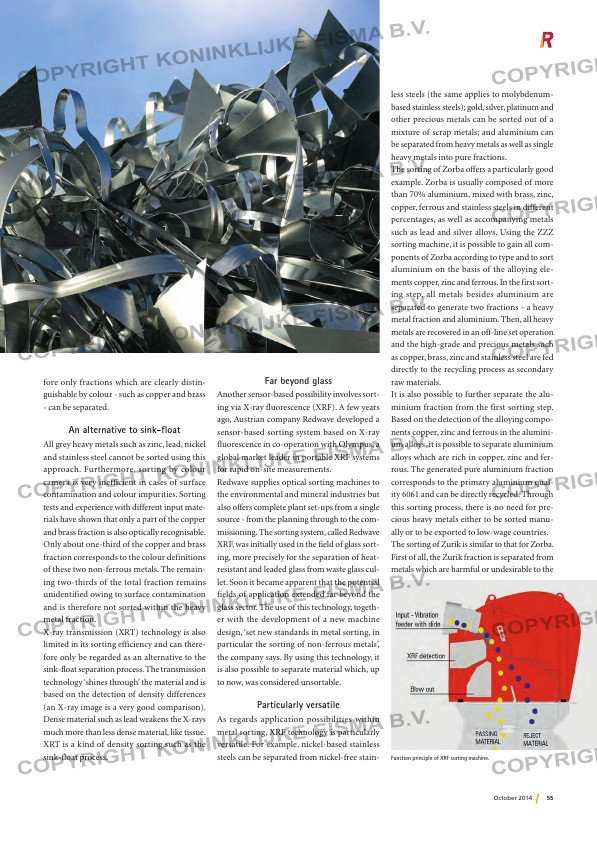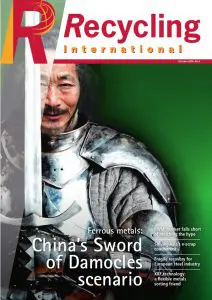Page 55 from: October 2014

55October 2014
fore only fractions which are clearly distin-
guishable by colour – such as copper and brass
– can be separated.
An alternative to sink-float
All grey heavy metals such as zinc, lead, nickel
and stainless steel cannot be sorted using this
approach. Furthermore, sorting by colour
camera is very inefficient in cases of surface
contamination and colour impurities. Sorting
tests and experience with different input mate-
rials have shown that only a part of the copper
and brass fraction is also optically recognisable.
Only about one-third of the copper and brass
fraction corresponds to the colour definitions
of these two non-ferrous metals. The remain-
ing two-thirds of the total fraction remains
unidentified owing to surface contamination
and is therefore not sorted within the heavy
metal fraction.
X-ray transmission (XRT) technology is also
limited in its sorting efficiency and can there-
fore only be regarded as an alternative to the
sink-float separation process. The transmission
technology ‘shines through’ the material and is
based on the detection of density differences
(an X-ray image is a very good comparison).
Dense material such as lead weakens the X-rays
much more than less dense material, like tissue.
XRT is a kind of density sorting such as the
sink-float process.
Far beyond glass
Another sensor-based possibility involves sort-
ing via X-ray fluorescence (XRF). A few years
ago, Austrian company Redwave developed a
sensor-based sorting system based on X-ray
fluorescence in co-operation with Olympus, a
global market leader in portable XRF systems
for rapid on-site measurements.
Redwave supplies optical sorting machines to
the environmental and mineral industries but
also offers complete plant set-ups from a single
source – from the planning through to the com-
missioning. The sorting system, called Redwave
XRF, was initially used in the field of glass sort-
ing, more precisely for the separation of heat-
resistant and leaded glass from waste glass cul-
let. Soon it became apparent that the potential
fields of application extended far beyond the
glass sector. The use of this technology, togeth-
er with the development of a new machine
design, ‘set new standards in metal sorting, in
particular the sorting of non-ferrous metals’,
the company says. By using this technology, it
is also possible to separate material which, up
to now, was considered unsortable.
Particularly versatile
As regards application possibilities within
metal sorting, XRF technology is particularly
versatile. For example, nickel-based stainless
steels can be separated from nickel-free stain-
less steels (the same applies to molybdenum-
based stainless steels); gold, silver, platinum and
other precious metals can be sorted out of a
mixture of scrap metals; and aluminium can
be separated from heavy metals as well as single
heavy metals into pure fractions.
The sorting of Zorba offers a particularly good
example. Zorba is usually composed of more
than 70% aluminium, mixed with brass, zinc,
copper, ferrous and stainless steels in different
percentages, as well as accompanying metals
such as lead and silver alloys. Using the ZZZ
sorting machine, it is possible to gain all com-
ponents of Zorba according to type and to sort
aluminium on the basis of the alloying ele-
ments copper, zinc and ferrous. In the first sort-
ing step, all metals besides aluminium are
separated to generate two fractions – a heavy
metal fraction and aluminium. Then, all heavy
metals are recovered in an off-line set operation
and the high-grade and precious metals such
as copper, brass, zinc and stainless steel are fed
directly to the recycling process as secondary
raw materials.
It is also possible to further separate the alu-
minium fraction from the first sorting step.
Based on the detection of the alloying compo-
nents copper, zinc and ferrous in the alumini-
um alloys, it is possible to separate aluminium
alloys which are rich in copper, zinc and fer-
rous. The generated pure aluminium fraction
corresponds to the primary aluminium qual-
ity 6061 and can be directly recycled. Through
this sorting process, there is no need for pre-
cious heavy metals either to be sorted manu-
ally or to be exported to low-wage countries.
The sorting of Zurik is similar to that for Zorba.
First of all, the Zurik fraction is separated from
metals which are harmful or undesirable to the
Function principle of XRF sorting machine.
RI8-Alu sorting.indd 55 06-10-14 17:41



